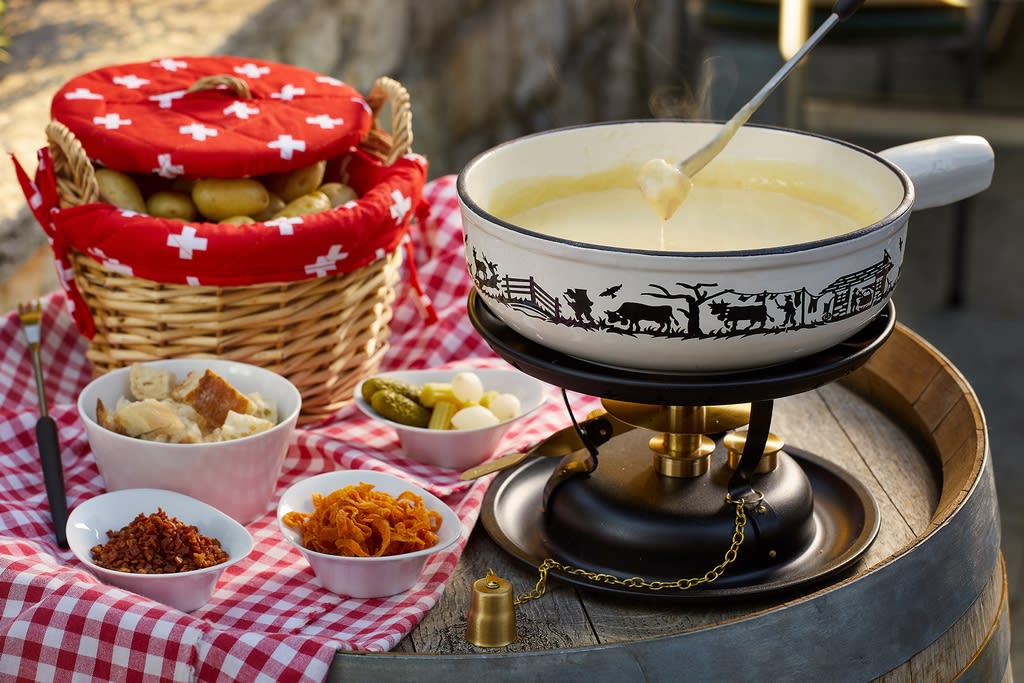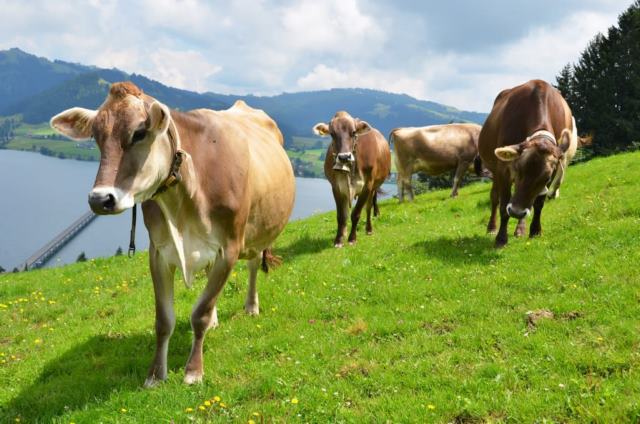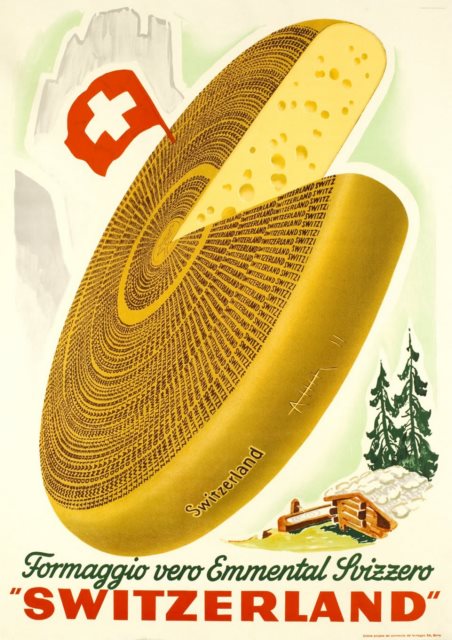mer, Oct 19th 2022
Historically neutral Switzerland has been waging battle over its famous Gruyère cheese due to a U.S. court ruling earlier this year which declared that ‘gruyère cheese’ can be made anywhere in the world.

A classic Swiss fondue recipe is “moitié-moitié” or “half and half” Gruyère cheese and Vacherin Fribourgeois, a cheese made in a nearby town.
What makes gruyère, ‘Gruyère’?
Swiss farmers are up in arms protesting the legal ramifications between U.S. cheese producers and producers in France and Switzerland over what makes gruyère, ‘Gruyère’? The Swiss and French Gruyère associations sought to register the name ‘Gruyère’ as a certification mark in the U.S., thereby allowing them to prohibit the use of the generic term ‘gruyère’ by other cheese producers outside of France and Switzerland.
Other European countries have also been persistent in protecting their culinary heritage. The European Union not only seeks to preserve the names of specific goods to promote their unique qualities that are connected to their geographical origin; it also attempts to eliminate names that have entered the public domain years ago by claiming protection by geographical indications.
After all, Swiss farmers have been producing Gruyère, a nutty and smooth cheese with fruity notes, in the Gruyères region of Switzerland since the 12th century. But due to a recent U.S. federal court ruling, ‘gruyère’ was determined to be a generic type of cheese that can be made anywhere.

The medieval town of Gruyères in the French-speaking part of Switzerland (Here Magazine).
Geographical Indications
Geographical Indications (GIs) are defined by Article 22.1 of the Agreement on Trade-Related Aspects of Intellectual Property Rights (TRIPS) as “…indications which identify a good as originating in the territory of a Member [of the World Trade Organization], or a region or locality in that territory, where a given quality, reputation or other characteristics of the good is essentially attributable to its geographical origin.”
Some examples of GIs include Parma ham, Toscano olives, Darjeeling tea, Florida oranges, Idaho potatoes, Napa Valley wines, Roquefort cheese, Vidalia onions, Washington apples, and of course, Champagne. Similar to trademarks, GIs are important to producers because they are source identifiers and serve as quality guarantees. As a result, producers can control the use of the mark and require GI users to adhere to production standards, which ultimately provides valuable business assets. GIs also prevent products from becoming generic, which could lead to unfair competition amongst producers, and mislead consumers about where the products originated.
Forget everything you know about dairy: Why Swiss cheese prevents heart attacks
To a greater extent, member states of the World Trade Organization (WTO) recognize that GIs are essential tools in the global economy. Furthermore, owners of intellectual property (IP) realize that protecting IP is no longer just a domestic matter. As such, IP owners must educate themselves about domestic and foreign GI protection structures to take advantage of the value added by GIs.However, these rules do not always apply in the U.S. For example, cheeses labeled Parmesan, feta, or Munster can be made anywhere. Moreover, the EU cannot prohibit European countries besides Switzerland and France from exporting cheese called gruyère to the U.S. According to the U.S. Department of Agriculture, the U.S. imported more cheese called gruyère from Germany and the Netherlands than from France and Switzerland between 2010 and 2020.

Switzerland’s beloved cattle are given freedom to roam and munch on the high-altitude grass and herbs — the reason why Swiss made cheese has a distinct flavor.
Switzerland’s losing battle
Earlier this year, Judge T. Ellis of the U.S. District Court in Virginia backed the judicial decision of the U.S. Patent and Trademark Office’s (USPTO) Trademark Trial and Appeal Board in denying the Swiss and French Gruyère Association’s application to prohibit the widespread generic use of the term ‘gruyère’ in the U.S. The finding acknowledges that all cheese producers – not just those hailing from France or Switzerland – can continue to produce and market cheese under this generic name.
Furthermore, the Consortium for Common Food Names (CCFN), National Milk Producers Federation (NMPF), U.S. Dairy Export Council (USDEC), and a group of other stakeholders succeeded in the continued battle to allow all producers in the U.S. market the right to use long-established generic terms. This victory sets an important precedent in the ongoing fight over food names in the U.S. especially considering the EU’s continued attempts to monopolize common names of products such as Parmesan, bologna, chateau, and gruyère.
The Court’s decision was mainly due to inadequate and unconvincing arguments from the French and Swiss Associations. Moreover, CCFN offered sufficient evidence that U.S. cheese consumers know that the word ‘gruyère’ is a generic word characteristic of a type of cheese without limitations and conditions as to the location the cheese is produced.
Furthermore, the CCFN, NMPF, and USDEC, along with support from member and non-member companies, supported the opposition throughout the appeal process. They argued that any dairy farmer should be able to continue to make and sell gruyère cheese in the U.S. by demonstrating the vast consumption of gruyère in the U.S. market.
Swiss and French gruyère producers already sell their cheese in the U.S. market with different trademark logos on their cheese. In addition, the USPTO has a registered logo certification from the Swiss association for ‘Le Gruyère Switzerland AOC’ to distinguish the unique Swiss Gruyère from other gruyères. But despite these trademark certifications, the French and Swiss Associations still appealed the USPTO’s ruling.
“This is a huge victory for common sense and for hard-working manufacturers and dairy farmers,” said USDEC president and CEO Krysta Harden. “When a word is used by multiple companies in multiple stores and restaurants every day for years, as gruyère has been, that word is generic, and no one owns the exclusive right to use it,” she said to the New York Times. Furthermore, the NMPF continues to fight the EU’s efforts to monopolize generic words like gruyère and to dismiss EU markets’ attempts to limit competition.

Switzerland’s other famous cheese, Emmental.
The Swiss government was dissatisfied with the U.S. Court’s decision and plans to appeal the ruling.
“Using the term ‘gruyère’ for a cheese produced in the United States threatens the reputation of the original product and its place in the foreign market and can only harm the entire sector,” said Jonathan Fisch, a spokesman for Switzerland’s Federal Office for Agriculture (FOAG).
According to a major Swiss cheese importer Caroline Hostettler of Quality Cheese, the Swiss mentality is too humble to market themselves and their products. For this reason, the Swiss have missed the train, so to speak, to protect the names of their products. And because the Swiss Cheese association receives money from the Swiss government, they will not appeal a ruling if it goes against the Swiss government.
“They are too neutral, too dependent on the Swiss government. So, the only way Swiss Gruyère AOP can save its identity is by continuing to distinguish itself from others. The Swiss must make great cheese and continue to educate consumers about why Swiss Gruyère is superior to the copies,” said Hostettler.
Cet article peut être librement partagé et réimprimé, à condition qu'il renvoie clairement à l'article original.
